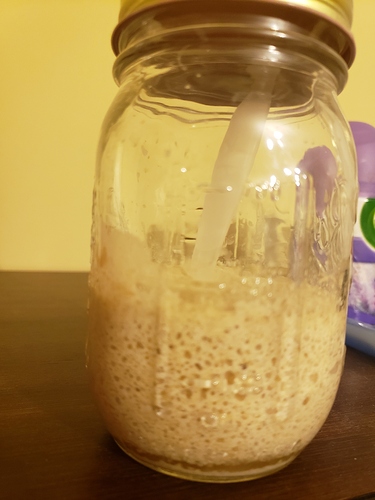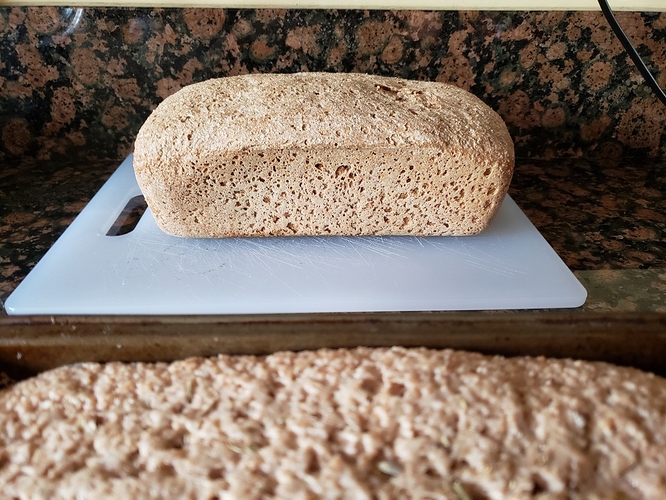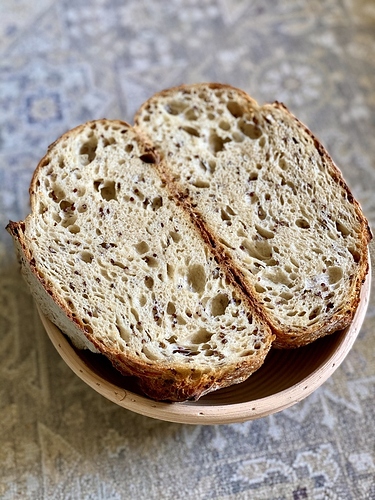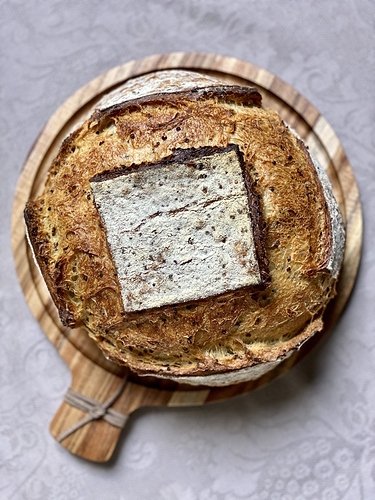Liz, What a perfect explanation! You have given me the basic info & the bits that I needed to understand. As I suspected, I am doing it correctly, & your brief description of hydration helps. Thank you for taking the time to respond. I’ll try this Kamut loaf later today. KD
You are welcome! I hope you love this bread … I am a huge fan of Kamut.
I recently made a sourdough Kamut bread (50% Kamut; 50% hard red) and it is delicious, my first time using Kamut. The crumb looks similar to the other whole grain ones on this thread. My only complaint is the crust is very soft. Really soft. In all my baking over the last few years, I’ve never had such a soft crust (not desirable for me!). I wonder if this is inherent to the Kamut and if others had the same problem. It was definitely done, and there was a bit of ear that was starting to get very dark. I suppose I could’ve left it in a little longer and will try that with the one I’m baking tomorrow.
Hi, first post her. I’ve made a few allpurpose flour leavens(?) in the past (adding 1oz flour 1oz water each day over the course of a few days to generate a natural yeast link here: https://slice.seriouseats.com/2010/11/how-to-make-sourdough-starter-day-0.html ).
My daughter will only do whole grain now and ive been trying to replicate the process with fresh ground whole grain kamut- maybe I’m giving up too early, but I’ve tried 3 times each time it has beautiful bubbles forming for the 1st 5 days or so (see picture), then it won’t bubble at all (imagine picture with no bubbles ><). It’s like overnight all the yeast runs away or disappears.
I guess my question is, can one create a leaven with kamut same way as with allpurpose flour?
Thanks
Starters can go through quiet periods after the initial burst of activity. Trick is to stop feeding it, keep warm and give it a stir twice a day (in place of a feed). It might take a few days but you should begin to see some activity then start up the feeds again.
You might have created your other starters in warmer weather in which case they would have been quicker to mature. Keep your starter as close to 75°F - 78°F as possible. In cooler weather they can take much longer.
Yup, what @anon44372566 said.
I’m going to guess that your initial bubbles were not being produced by yeast but by bacteria and that after the period of not much happening, you might again see some activity that is actually yeast-produced bubbles. I just wrote an extended ramble about creating a starter from scratch which I did recently:
Thanks Paul & Abe… I’m guessing those initial bubbles in the first 4 days are the non-yeasty bubbles… I’ll continue to feed my little jar of liquid goo in hopes that the yeast fights it out & wins the various battles of the microbians.
I think I was just trying to confirm it is possible to create a whole grain starter with Kamut along with troubleshooting the idea that it seemed to not stay alive. I think part2 is solved by approaching with more patience. Any thoughts on pt1: Creating the starter with Kamut?
I’ve never done it, but I’d be very surprised if whole Kamut wouldn’t work fine to create a starter. My guess is that any whole grain is probably going to work faster than a refined flour like I used.
There might very well be yeast present in the initial bubbling up but not in strong enough numbers. Bacteria are quick off the mark, they’re more dominant and quite often leuconostoc in nature.
Rule of thumb is feed if you see activity. If no activity then what are you feeding? Best thing you can do is keep it warm and stir. Once you see some activity then feed. But not too much too often. Allow the starter to dictate, in this early stage, when it needs food and how much. Read the starter!
No difference when it comes to kamut. I’ve made rye starters, wheat, buckwheat, durum (of which kamut is a variety) etc.
Melissa, I have organic Kamut grain that I mill myself. Do you leave the bran in the flour or sift it out? Some of the blogs I’ve read on the Breadtopia website seem to indicate long fermentation periods like the one used in this recipe help soften the bran and cut back on the negative impact on oven spring. Can you comment on this?
Thanks!
I’m not a big sifter simply due to wanting the nutrients in bran and being on the lazy side for sifting, soaking, and returning the bran to the dough. Though I did just do this experiment
I agree that the rule of thumb is: take some bran out and you’ll improve oven spring/gluten development. I think Kamut is going to be somewhat gluten-challenged, regardless of the bran situation. Though not to the extent of einkorn, for example.
In my limited experience, using only whole grain Kamut wheat, even with a long fermentation, yields a delicious, golden, not-tall loaf. However, in this recipe blog aka my experience with 100% whole grain kamut bread : ), my dough was very wet, and I probably could have gotten a taller loaf with a lower hydration.
@anon66425146 may be able to offer more insight as as she bakes with Kamut frequently.
I do use Kamut (Breadtopia bolted), but I don’t mill so can’t add to the discussion.
Thanks for your response. After reading the article you attached, I would agree with your initial statement that sifting and boiling isn’t really worth it. Getting the perfect ear and bloom is something nice to achieve but does little to improve the taste and enjoyment of a homemade loaf!
You’re welcome : )
I was finally able to get a good somewhat risen loaf from home milled whole Kamut/red wheat/spelt grains… my daughter was pleased with it- though the one in the foreground popped
Hi, would you have ANY idea what I’m missing when allowing the dough to rise? Here’s a picture of the top- it rises a bit but seems to just have an ugly bubbly surface… sometimes it will keep a relative constant skin on top but rarely. I use a stand mixer to knead it for about 20min & cover it with plastic wrap. Any ideas? Dough too wet? Too dry? Not kneaded enough? Thanks!
I’ve never made 100% Kamut/whole wheat … @Fermentada notes in the recipe that her 100% Kamut had popped bubbles but I don’t see too much of that in her photos, unlike yours.
My first impression of the photo without reading your comment history or the recipe notes was “too wet” and under proofed but that is just an inexperienced guess!
That’s gorgeous. I’m curious if you precooked the quinoa.
Thank you.
I had cooked quinoa in fridge and add them in the lamination step.
unplanned  !
!
I also swapped 100g of the bread flour to 100g all purpose.
i’m thinking next time to increase the % to 30-40 to enhance the flavor, I felt the stickiness in 20% 




